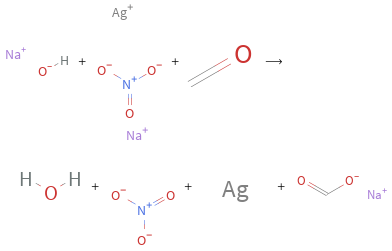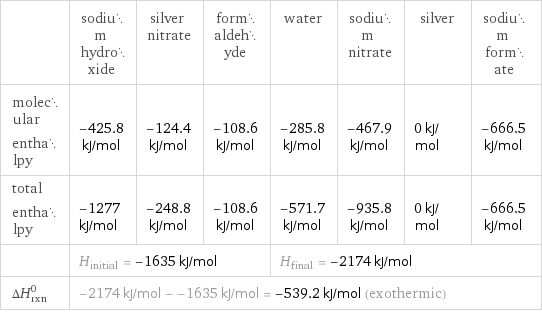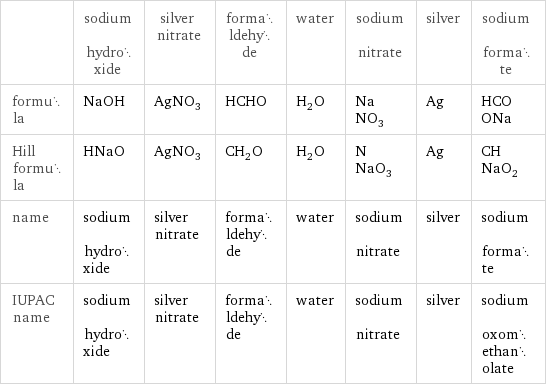Input interpretation

NaOH sodium hydroxide + AgNO_3 silver nitrate + HCHO formaldehyde ⟶ H_2O water + NaNO_3 sodium nitrate + Ag silver + HCOONa sodium formate
Balanced equation

Balance the chemical equation algebraically: NaOH + AgNO_3 + HCHO ⟶ H_2O + NaNO_3 + Ag + HCOONa Add stoichiometric coefficients, c_i, to the reactants and products: c_1 NaOH + c_2 AgNO_3 + c_3 HCHO ⟶ c_4 H_2O + c_5 NaNO_3 + c_6 Ag + c_7 HCOONa Set the number of atoms in the reactants equal to the number of atoms in the products for H, Na, O, Ag, N and C: H: | c_1 + 2 c_3 = 2 c_4 + c_7 Na: | c_1 = c_5 + c_7 O: | c_1 + 3 c_2 + c_3 = c_4 + 3 c_5 + 2 c_7 Ag: | c_2 = c_6 N: | c_2 = c_5 C: | c_3 = c_7 Since the coefficients are relative quantities and underdetermined, choose a coefficient to set arbitrarily. To keep the coefficients small, the arbitrary value is ordinarily one. For instance, set c_3 = 1 and solve the system of equations for the remaining coefficients: c_1 = 3 c_2 = 2 c_3 = 1 c_4 = 2 c_5 = 2 c_6 = 2 c_7 = 1 Substitute the coefficients into the chemical reaction to obtain the balanced equation: Answer: | | 3 NaOH + 2 AgNO_3 + HCHO ⟶ 2 H_2O + 2 NaNO_3 + 2 Ag + HCOONa
Structures

+ + ⟶ + + +
Names

sodium hydroxide + silver nitrate + formaldehyde ⟶ water + sodium nitrate + silver + sodium formate
Reaction thermodynamics
Enthalpy

| sodium hydroxide | silver nitrate | formaldehyde | water | sodium nitrate | silver | sodium formate molecular enthalpy | -425.8 kJ/mol | -124.4 kJ/mol | -108.6 kJ/mol | -285.8 kJ/mol | -467.9 kJ/mol | 0 kJ/mol | -666.5 kJ/mol total enthalpy | -1277 kJ/mol | -248.8 kJ/mol | -108.6 kJ/mol | -571.7 kJ/mol | -935.8 kJ/mol | 0 kJ/mol | -666.5 kJ/mol | H_initial = -1635 kJ/mol | | | H_final = -2174 kJ/mol | | | ΔH_rxn^0 | -2174 kJ/mol - -1635 kJ/mol = -539.2 kJ/mol (exothermic) | | | | | |
Equilibrium constant
![Construct the equilibrium constant, K, expression for: NaOH + AgNO_3 + HCHO ⟶ H_2O + NaNO_3 + Ag + HCOONa Plan: • Balance the chemical equation. • Determine the stoichiometric numbers. • Assemble the activity expression for each chemical species. • Use the activity expressions to build the equilibrium constant expression. Write the balanced chemical equation: 3 NaOH + 2 AgNO_3 + HCHO ⟶ 2 H_2O + 2 NaNO_3 + 2 Ag + HCOONa Assign stoichiometric numbers, ν_i, using the stoichiometric coefficients, c_i, from the balanced chemical equation in the following manner: ν_i = -c_i for reactants and ν_i = c_i for products: chemical species | c_i | ν_i NaOH | 3 | -3 AgNO_3 | 2 | -2 HCHO | 1 | -1 H_2O | 2 | 2 NaNO_3 | 2 | 2 Ag | 2 | 2 HCOONa | 1 | 1 Assemble the activity expressions accounting for the state of matter and ν_i: chemical species | c_i | ν_i | activity expression NaOH | 3 | -3 | ([NaOH])^(-3) AgNO_3 | 2 | -2 | ([AgNO3])^(-2) HCHO | 1 | -1 | ([HCHO])^(-1) H_2O | 2 | 2 | ([H2O])^2 NaNO_3 | 2 | 2 | ([NaNO3])^2 Ag | 2 | 2 | ([Ag])^2 HCOONa | 1 | 1 | [HCOONa] The equilibrium constant symbol in the concentration basis is: K_c Mulitply the activity expressions to arrive at the K_c expression: Answer: | | K_c = ([NaOH])^(-3) ([AgNO3])^(-2) ([HCHO])^(-1) ([H2O])^2 ([NaNO3])^2 ([Ag])^2 [HCOONa] = (([H2O])^2 ([NaNO3])^2 ([Ag])^2 [HCOONa])/(([NaOH])^3 ([AgNO3])^2 [HCHO])](../image_source/00591028d3aea9ddced2e66001c485ca.png)
Construct the equilibrium constant, K, expression for: NaOH + AgNO_3 + HCHO ⟶ H_2O + NaNO_3 + Ag + HCOONa Plan: • Balance the chemical equation. • Determine the stoichiometric numbers. • Assemble the activity expression for each chemical species. • Use the activity expressions to build the equilibrium constant expression. Write the balanced chemical equation: 3 NaOH + 2 AgNO_3 + HCHO ⟶ 2 H_2O + 2 NaNO_3 + 2 Ag + HCOONa Assign stoichiometric numbers, ν_i, using the stoichiometric coefficients, c_i, from the balanced chemical equation in the following manner: ν_i = -c_i for reactants and ν_i = c_i for products: chemical species | c_i | ν_i NaOH | 3 | -3 AgNO_3 | 2 | -2 HCHO | 1 | -1 H_2O | 2 | 2 NaNO_3 | 2 | 2 Ag | 2 | 2 HCOONa | 1 | 1 Assemble the activity expressions accounting for the state of matter and ν_i: chemical species | c_i | ν_i | activity expression NaOH | 3 | -3 | ([NaOH])^(-3) AgNO_3 | 2 | -2 | ([AgNO3])^(-2) HCHO | 1 | -1 | ([HCHO])^(-1) H_2O | 2 | 2 | ([H2O])^2 NaNO_3 | 2 | 2 | ([NaNO3])^2 Ag | 2 | 2 | ([Ag])^2 HCOONa | 1 | 1 | [HCOONa] The equilibrium constant symbol in the concentration basis is: K_c Mulitply the activity expressions to arrive at the K_c expression: Answer: | | K_c = ([NaOH])^(-3) ([AgNO3])^(-2) ([HCHO])^(-1) ([H2O])^2 ([NaNO3])^2 ([Ag])^2 [HCOONa] = (([H2O])^2 ([NaNO3])^2 ([Ag])^2 [HCOONa])/(([NaOH])^3 ([AgNO3])^2 [HCHO])
Rate of reaction
![Construct the rate of reaction expression for: NaOH + AgNO_3 + HCHO ⟶ H_2O + NaNO_3 + Ag + HCOONa Plan: • Balance the chemical equation. • Determine the stoichiometric numbers. • Assemble the rate term for each chemical species. • Write the rate of reaction expression. Write the balanced chemical equation: 3 NaOH + 2 AgNO_3 + HCHO ⟶ 2 H_2O + 2 NaNO_3 + 2 Ag + HCOONa Assign stoichiometric numbers, ν_i, using the stoichiometric coefficients, c_i, from the balanced chemical equation in the following manner: ν_i = -c_i for reactants and ν_i = c_i for products: chemical species | c_i | ν_i NaOH | 3 | -3 AgNO_3 | 2 | -2 HCHO | 1 | -1 H_2O | 2 | 2 NaNO_3 | 2 | 2 Ag | 2 | 2 HCOONa | 1 | 1 The rate term for each chemical species, B_i, is 1/ν_i(Δ[B_i])/(Δt) where [B_i] is the amount concentration and t is time: chemical species | c_i | ν_i | rate term NaOH | 3 | -3 | -1/3 (Δ[NaOH])/(Δt) AgNO_3 | 2 | -2 | -1/2 (Δ[AgNO3])/(Δt) HCHO | 1 | -1 | -(Δ[HCHO])/(Δt) H_2O | 2 | 2 | 1/2 (Δ[H2O])/(Δt) NaNO_3 | 2 | 2 | 1/2 (Δ[NaNO3])/(Δt) Ag | 2 | 2 | 1/2 (Δ[Ag])/(Δt) HCOONa | 1 | 1 | (Δ[HCOONa])/(Δt) (for infinitesimal rate of change, replace Δ with d) Set the rate terms equal to each other to arrive at the rate expression: Answer: | | rate = -1/3 (Δ[NaOH])/(Δt) = -1/2 (Δ[AgNO3])/(Δt) = -(Δ[HCHO])/(Δt) = 1/2 (Δ[H2O])/(Δt) = 1/2 (Δ[NaNO3])/(Δt) = 1/2 (Δ[Ag])/(Δt) = (Δ[HCOONa])/(Δt) (assuming constant volume and no accumulation of intermediates or side products)](../image_source/67890bbb4bbb783c2c3815d768dbdd84.png)
Construct the rate of reaction expression for: NaOH + AgNO_3 + HCHO ⟶ H_2O + NaNO_3 + Ag + HCOONa Plan: • Balance the chemical equation. • Determine the stoichiometric numbers. • Assemble the rate term for each chemical species. • Write the rate of reaction expression. Write the balanced chemical equation: 3 NaOH + 2 AgNO_3 + HCHO ⟶ 2 H_2O + 2 NaNO_3 + 2 Ag + HCOONa Assign stoichiometric numbers, ν_i, using the stoichiometric coefficients, c_i, from the balanced chemical equation in the following manner: ν_i = -c_i for reactants and ν_i = c_i for products: chemical species | c_i | ν_i NaOH | 3 | -3 AgNO_3 | 2 | -2 HCHO | 1 | -1 H_2O | 2 | 2 NaNO_3 | 2 | 2 Ag | 2 | 2 HCOONa | 1 | 1 The rate term for each chemical species, B_i, is 1/ν_i(Δ[B_i])/(Δt) where [B_i] is the amount concentration and t is time: chemical species | c_i | ν_i | rate term NaOH | 3 | -3 | -1/3 (Δ[NaOH])/(Δt) AgNO_3 | 2 | -2 | -1/2 (Δ[AgNO3])/(Δt) HCHO | 1 | -1 | -(Δ[HCHO])/(Δt) H_2O | 2 | 2 | 1/2 (Δ[H2O])/(Δt) NaNO_3 | 2 | 2 | 1/2 (Δ[NaNO3])/(Δt) Ag | 2 | 2 | 1/2 (Δ[Ag])/(Δt) HCOONa | 1 | 1 | (Δ[HCOONa])/(Δt) (for infinitesimal rate of change, replace Δ with d) Set the rate terms equal to each other to arrive at the rate expression: Answer: | | rate = -1/3 (Δ[NaOH])/(Δt) = -1/2 (Δ[AgNO3])/(Δt) = -(Δ[HCHO])/(Δt) = 1/2 (Δ[H2O])/(Δt) = 1/2 (Δ[NaNO3])/(Δt) = 1/2 (Δ[Ag])/(Δt) = (Δ[HCOONa])/(Δt) (assuming constant volume and no accumulation of intermediates or side products)
Chemical names and formulas

| sodium hydroxide | silver nitrate | formaldehyde | water | sodium nitrate | silver | sodium formate formula | NaOH | AgNO_3 | HCHO | H_2O | NaNO_3 | Ag | HCOONa Hill formula | HNaO | AgNO_3 | CH_2O | H_2O | NNaO_3 | Ag | CHNaO_2 name | sodium hydroxide | silver nitrate | formaldehyde | water | sodium nitrate | silver | sodium formate IUPAC name | sodium hydroxide | silver nitrate | formaldehyde | water | sodium nitrate | silver | sodium oxomethanolate